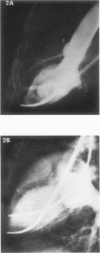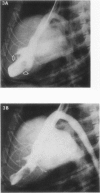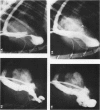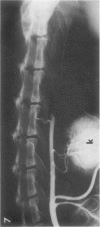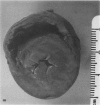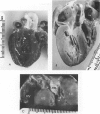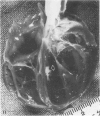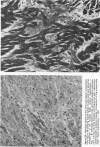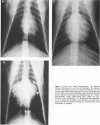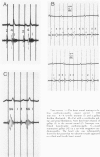Abstract
Thirty-four cats with primary myocardial disease were studied. The cats were divided into two groups, depending on the clinical, hemodynamic, angiocardiographic, and pathologic findings. Group A consisted of those cats with hypertrophic cardiomyopathy and Group B consisted of those cats with congestive cardiomyopathy. Similarity in the characteristics of cardiomyopathy in the human cat was found. Both Group A and Group B consisted predominantly of mature adult male cats. The most common presenting signs were dyspnea and/or thromboembolism, systolic murmurs with gallop rhythms on auscultation, cardiomegaly with (Group A) or without (Group B) pulmonary edema, abnormal electrocardiograms, elevated left ventricular end diastolic pressures, and angiocardiographic evidence of mitral regurgitation with left ventricular concentric hypertrophy (Group A) or left ventricular dilatation (Group B). Some cats in Group A also had evidence of left ventricular outflow obstruction. The principal pathologic findings in these cats were left atrial dilatation, symmetric hypertrophy or asymmetric septal hypertrophy of the left ventricle (Group A), and dilatation of the four cardiac chambers (Group B). Aortic thromboembolism was commonly observed in both groups. These clinical and pathologic findings indicate that cardiomyopathy in the cat is similar to the two most common forms of cardiomyopathy in the human (hypertrophic cardiomyopathy, with and without obstruction, and congestive cardiomyopathy).
Full text
PDF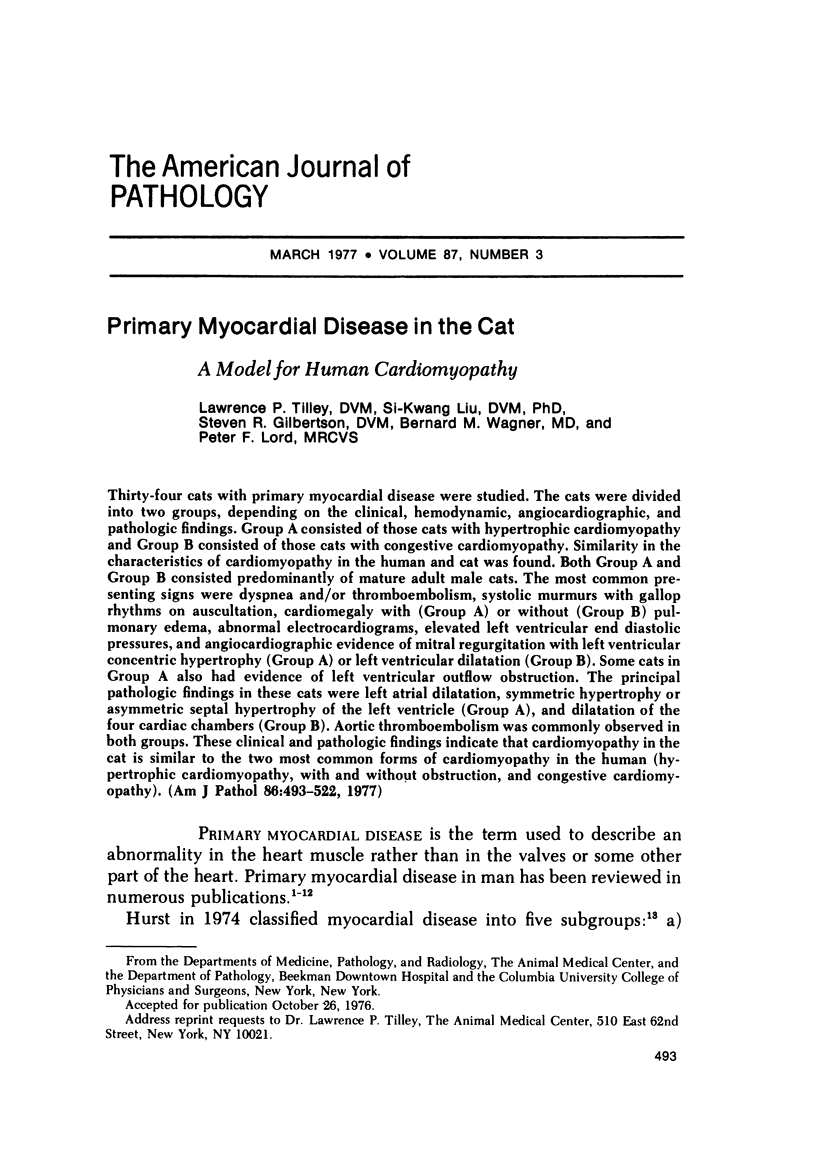
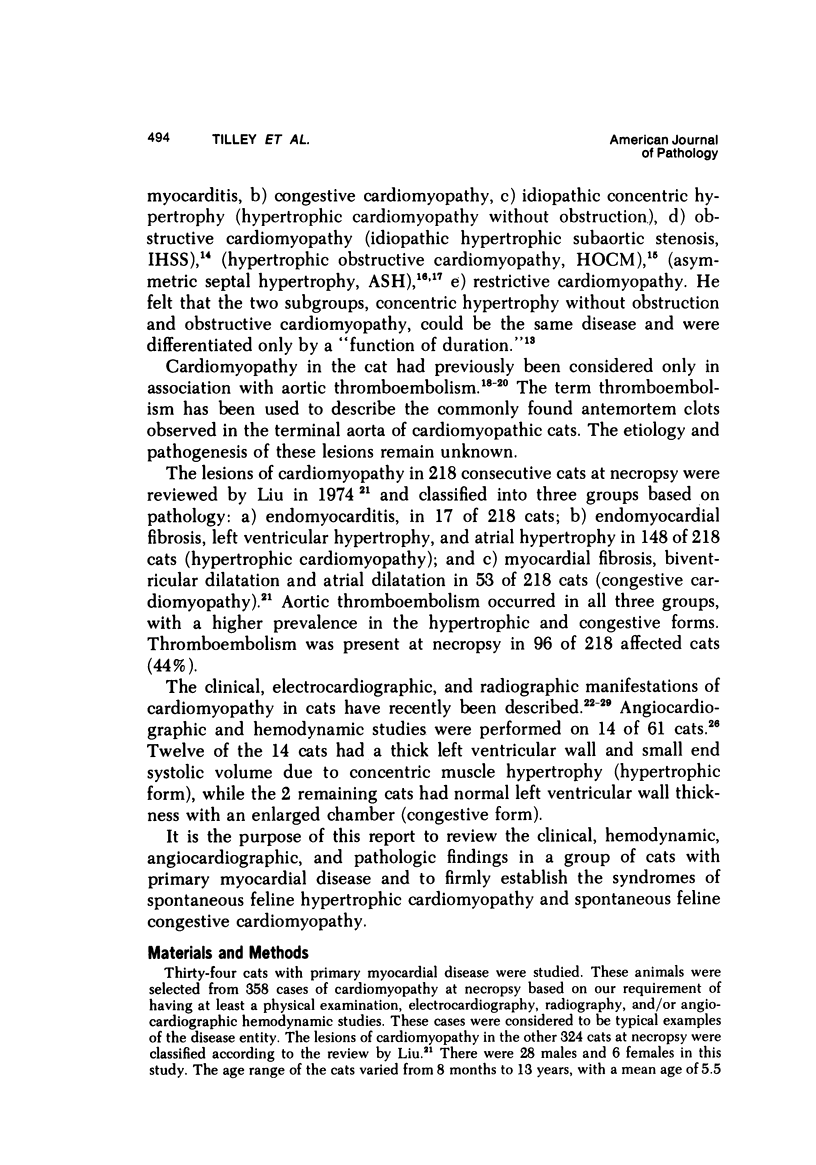
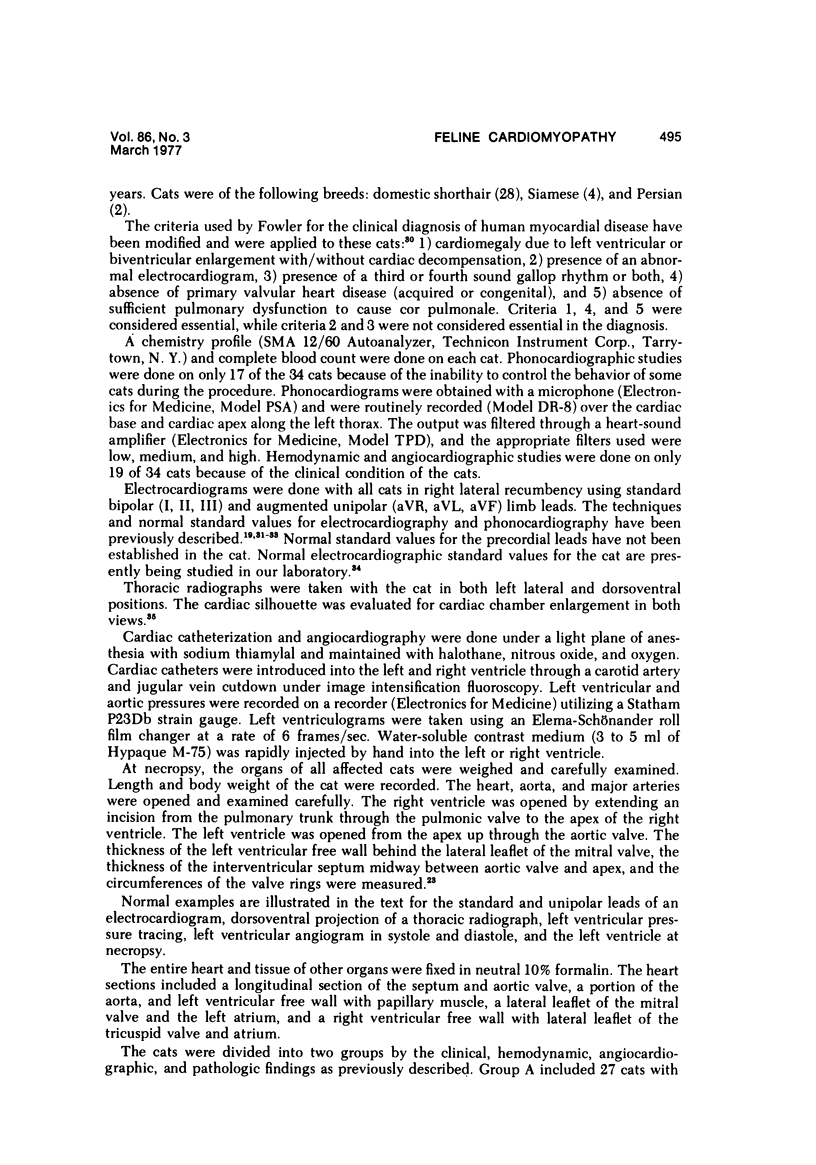

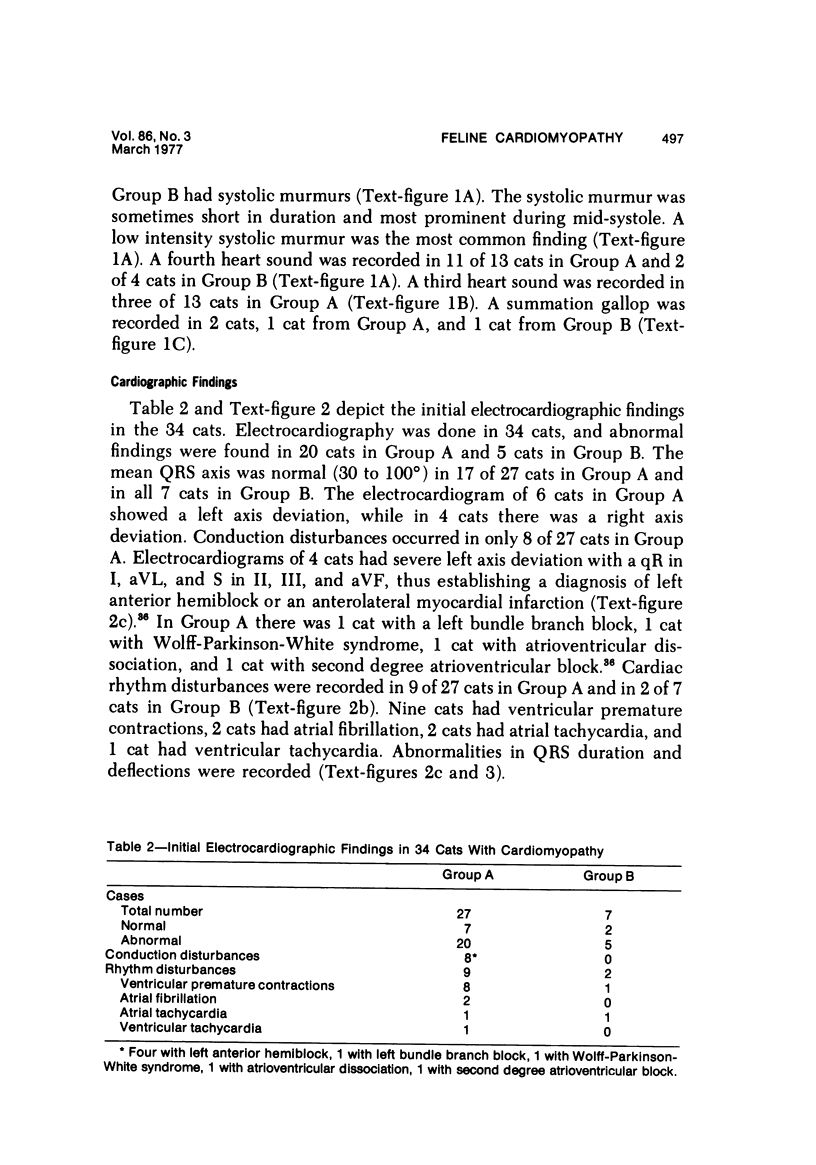
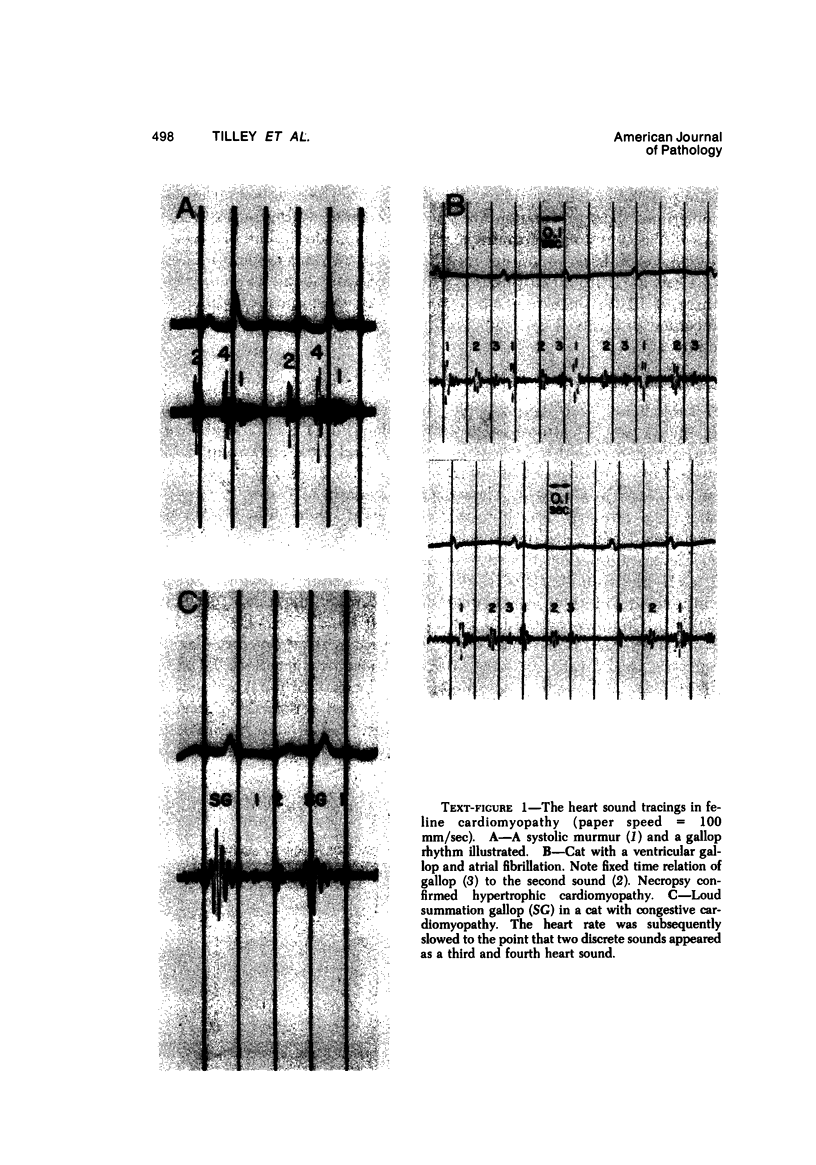
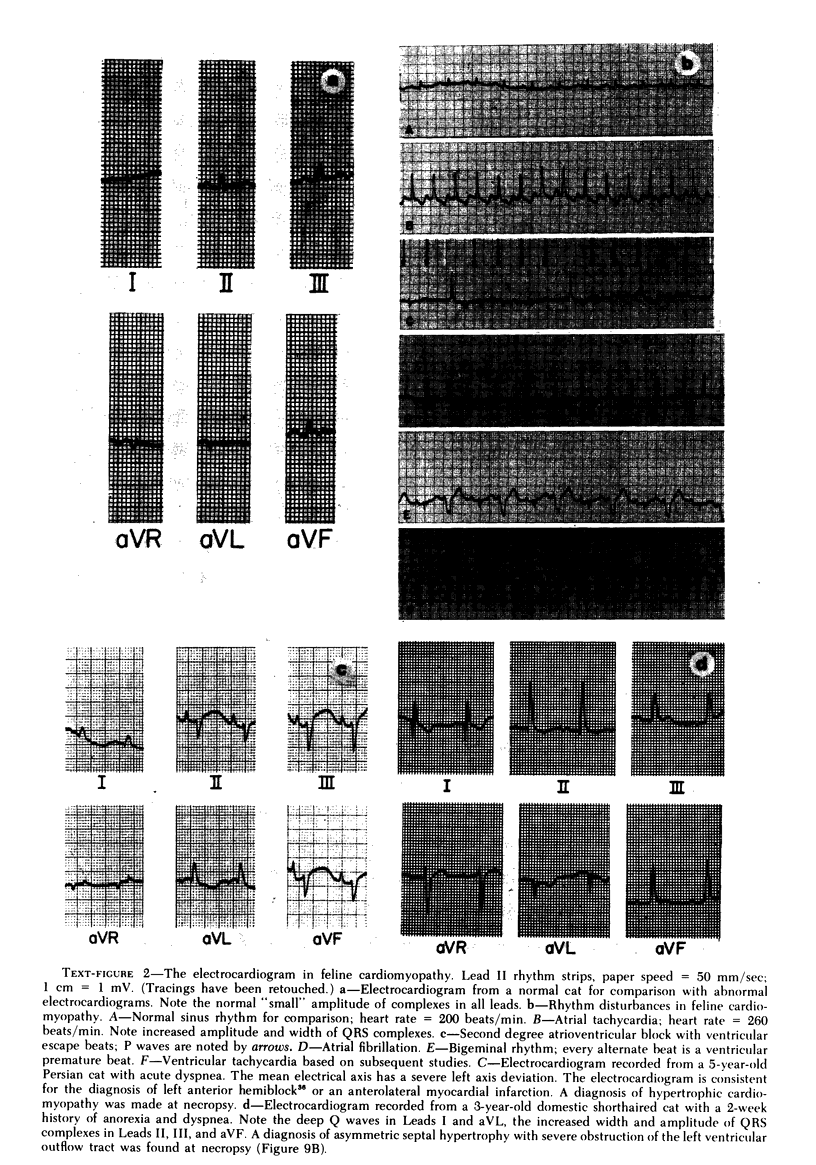
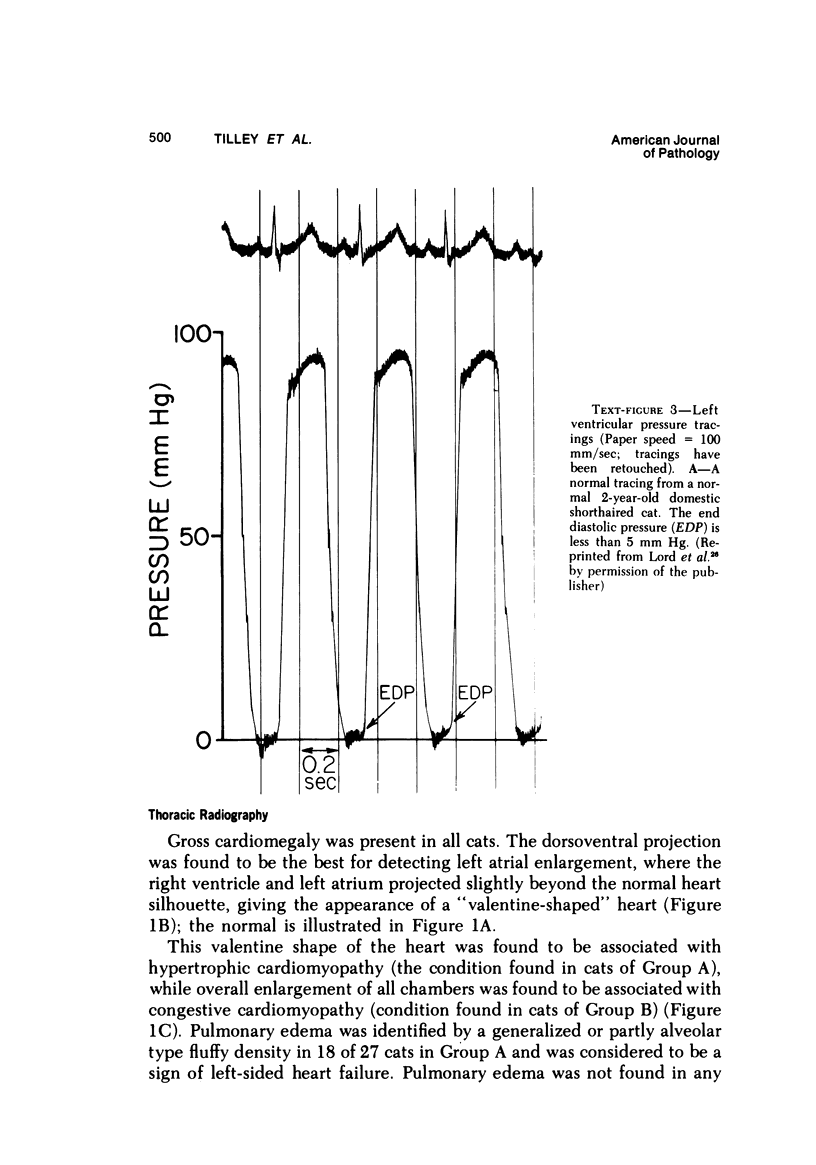
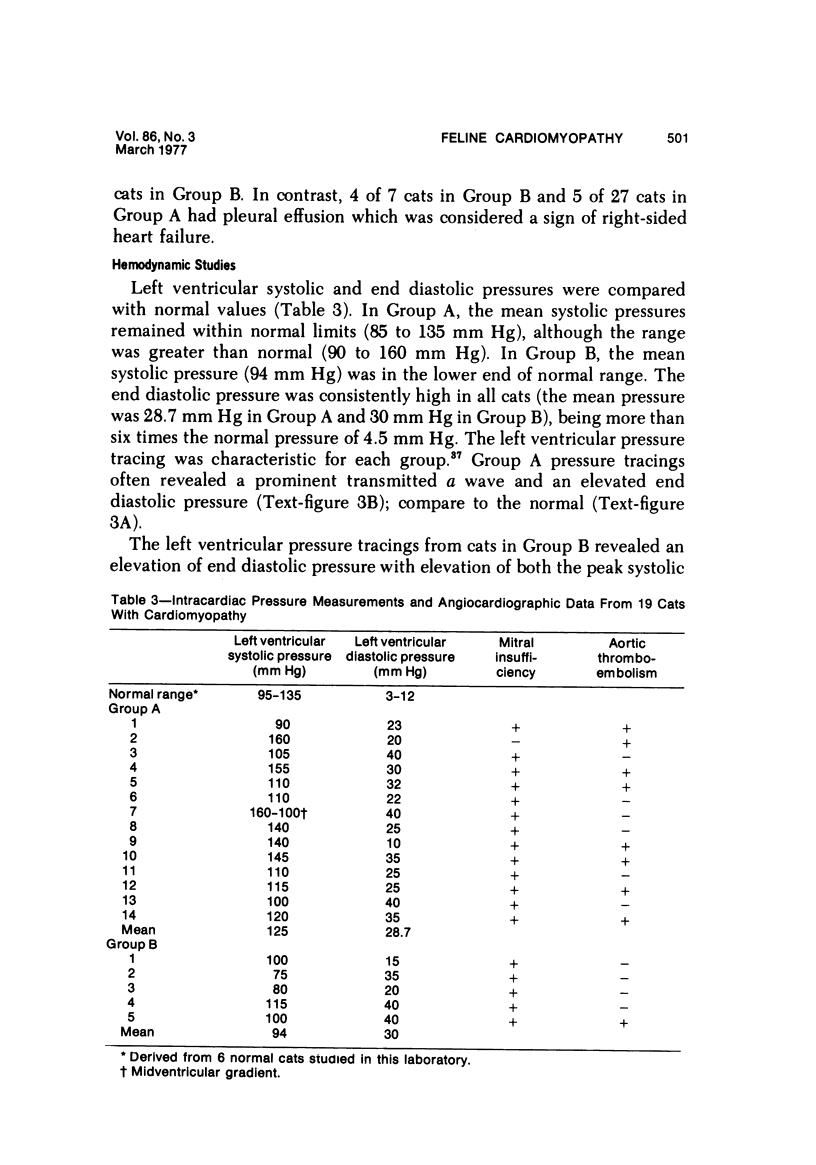
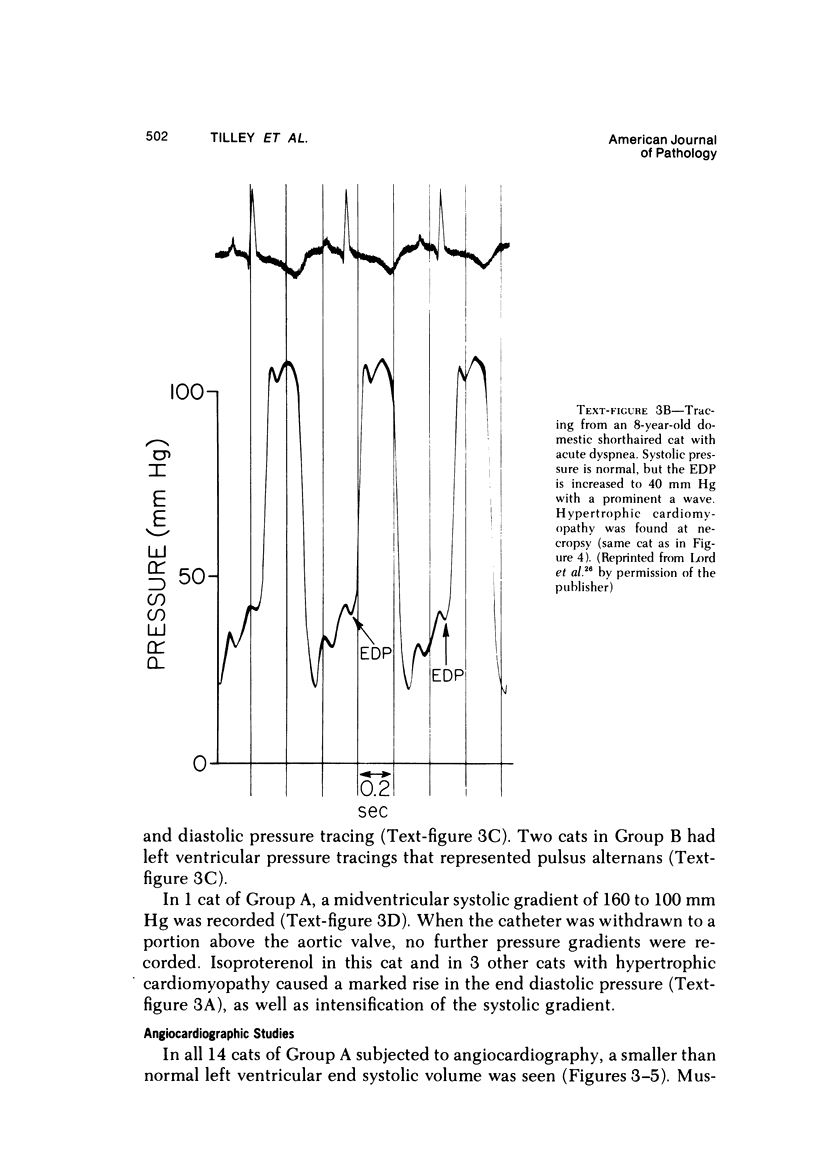
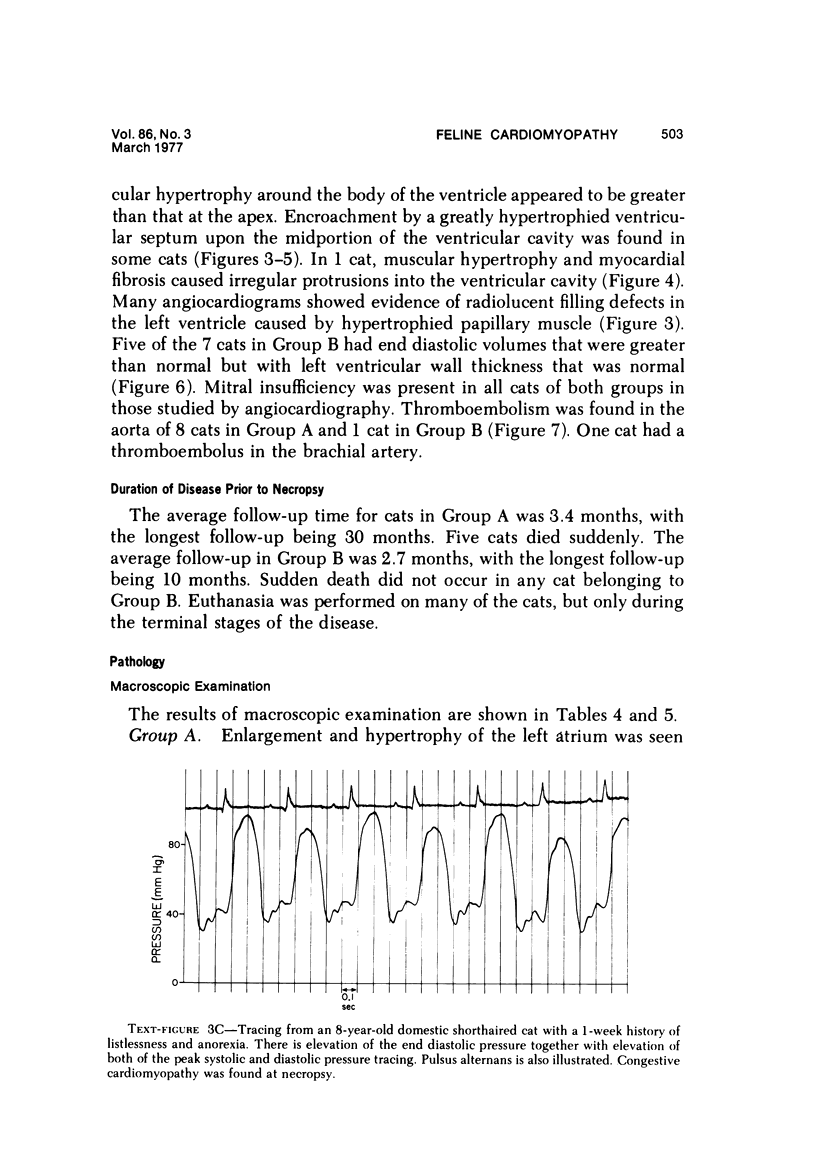

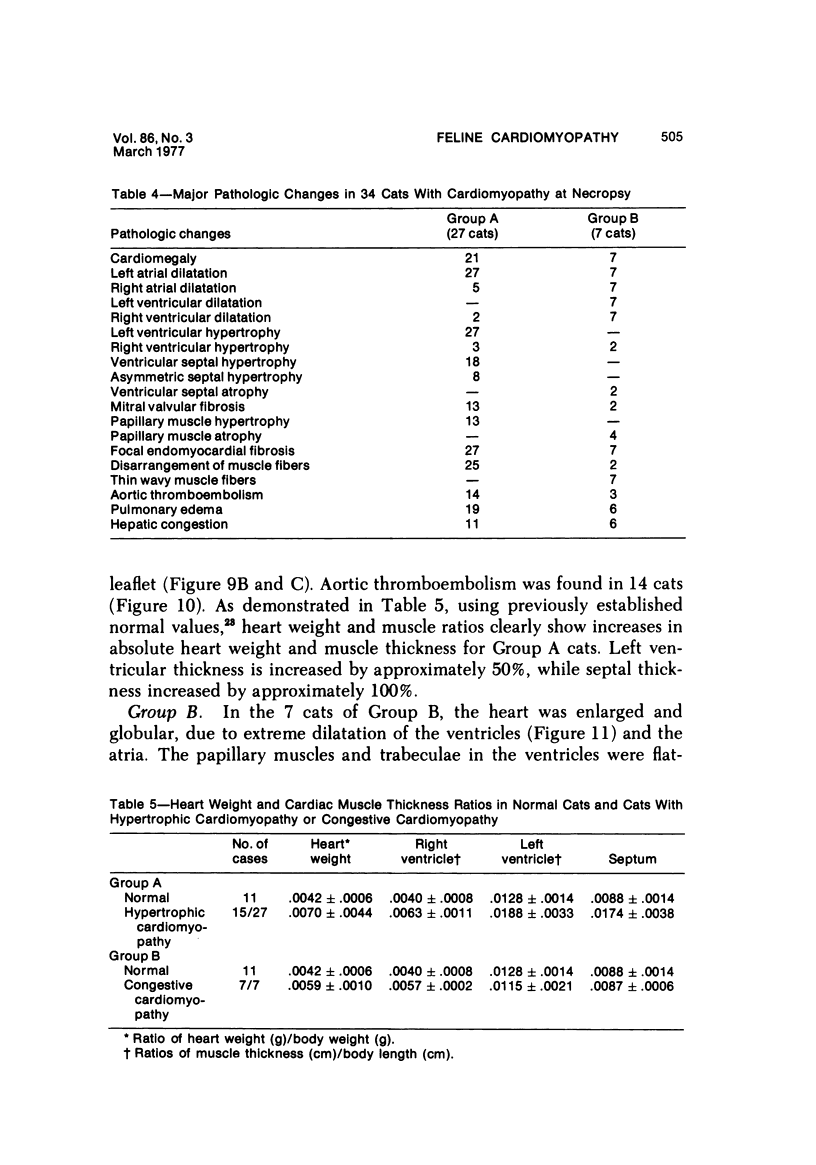
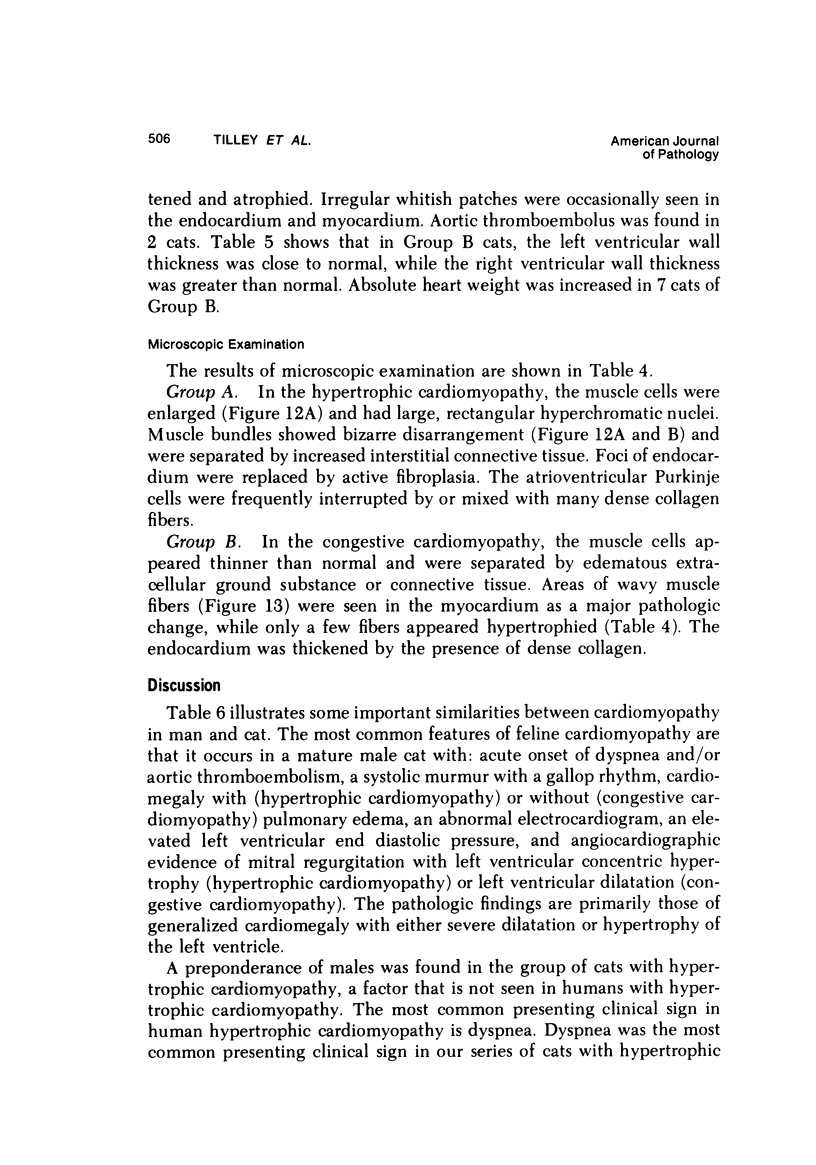
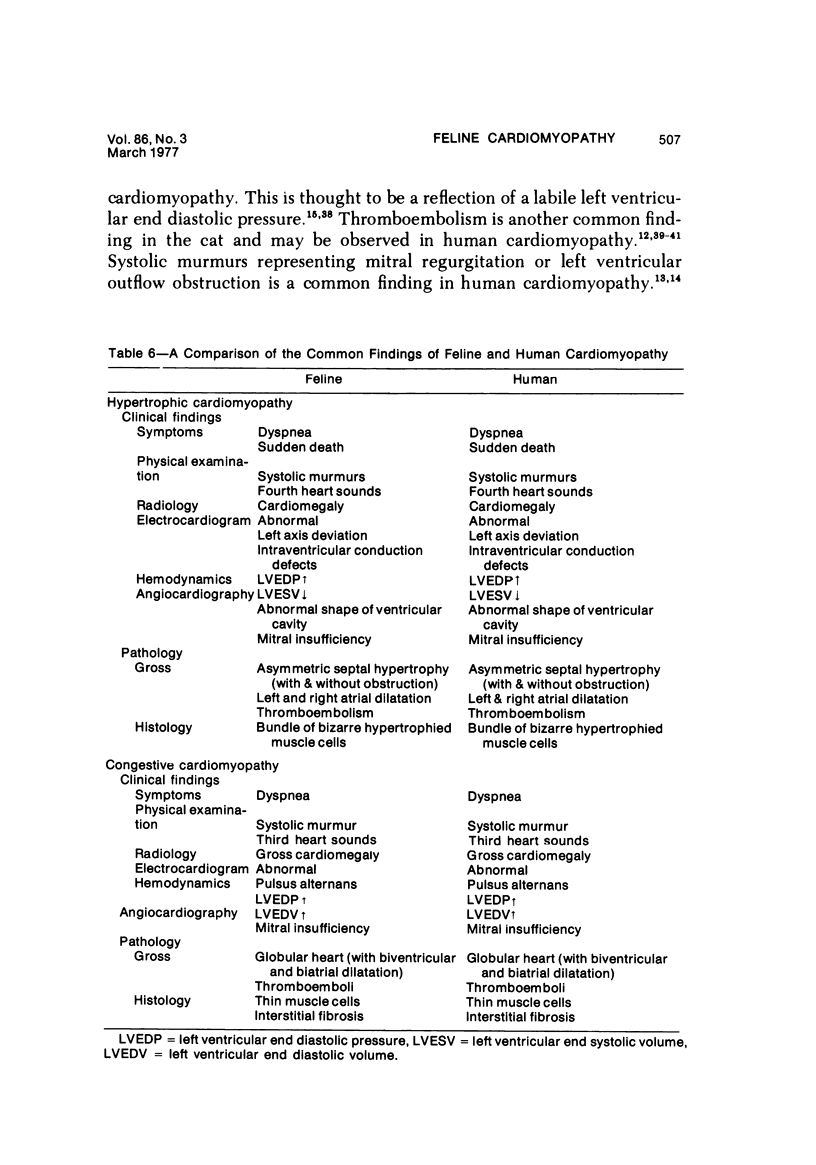
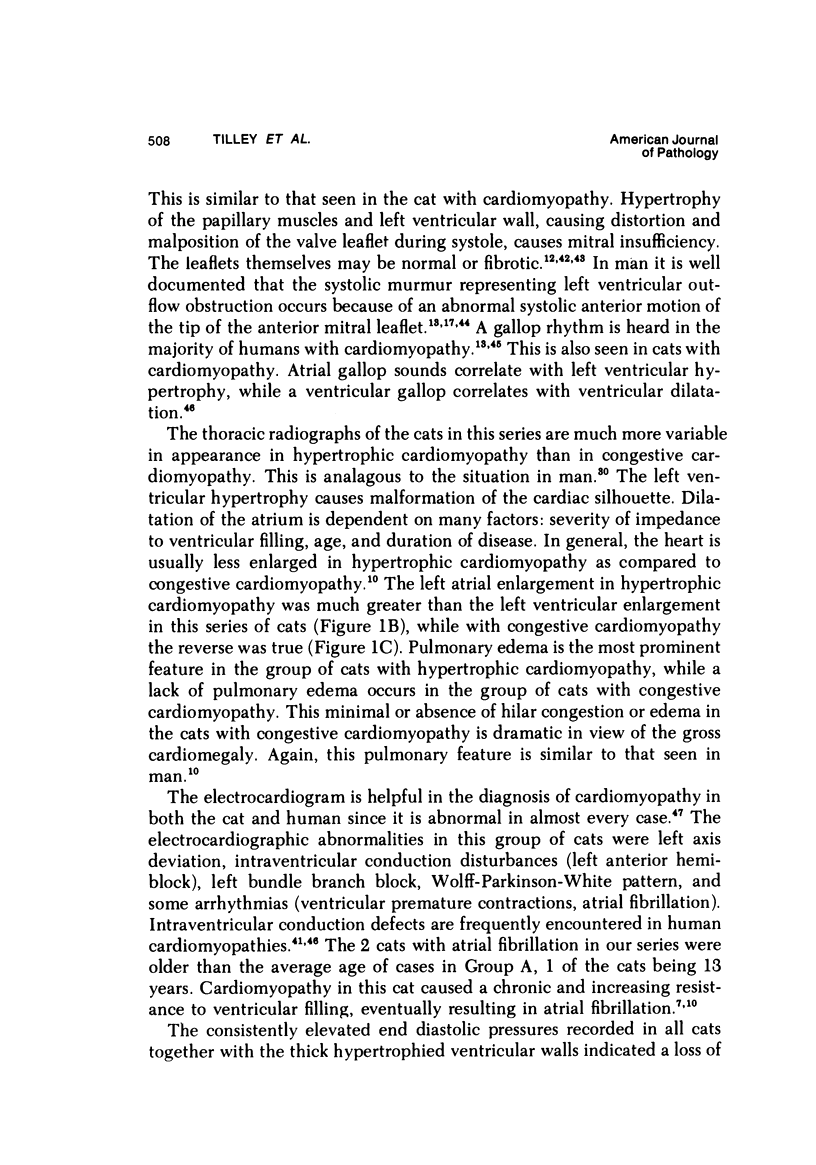
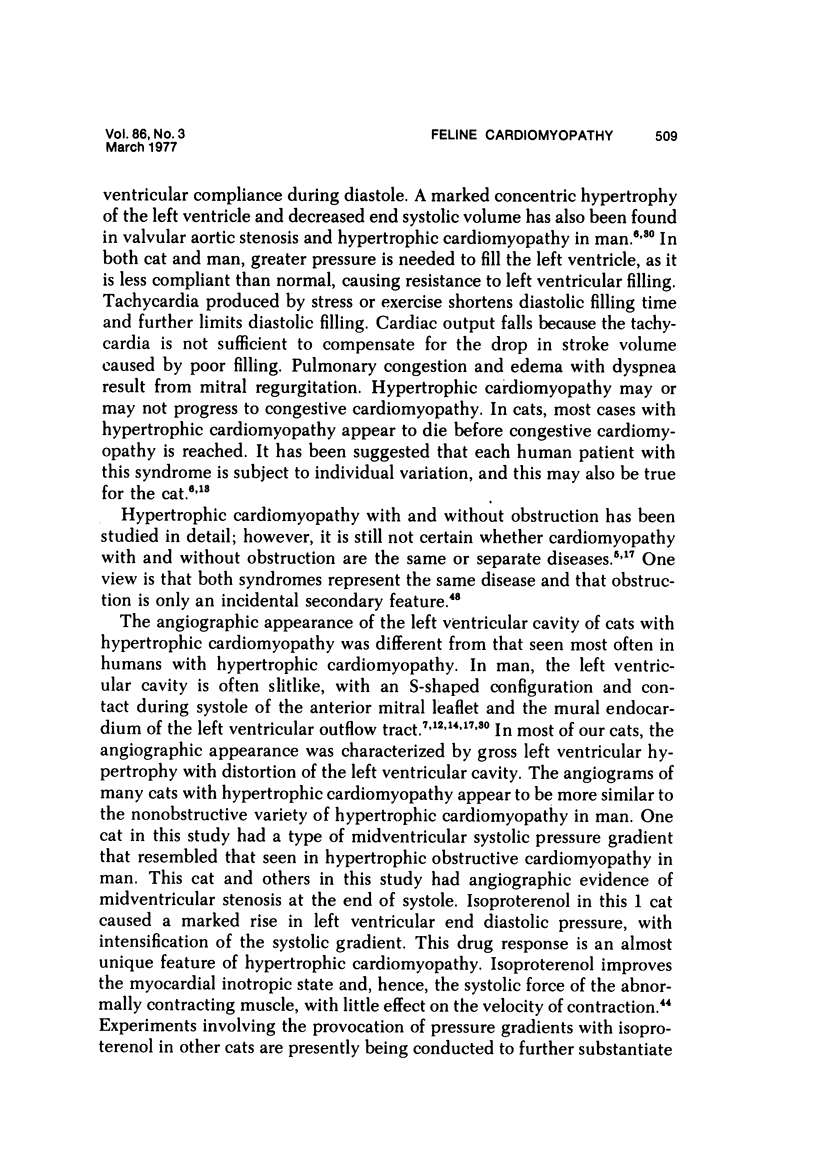
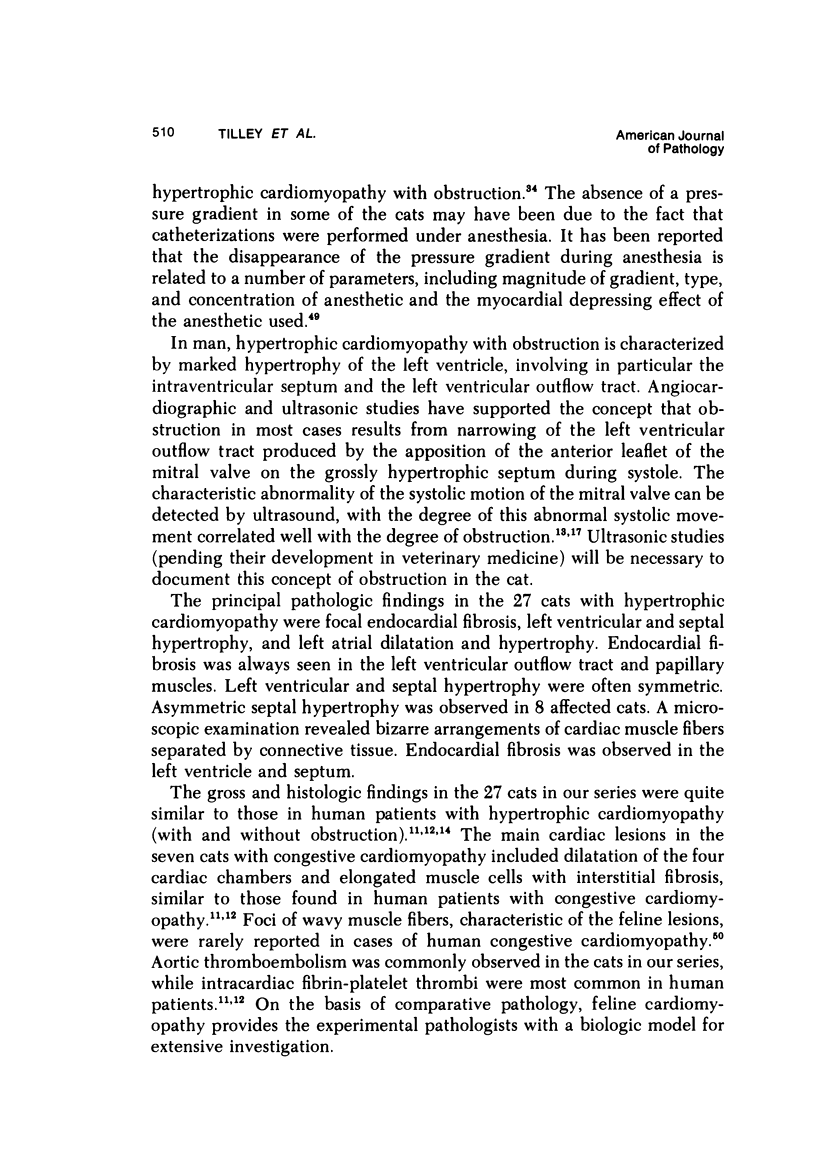
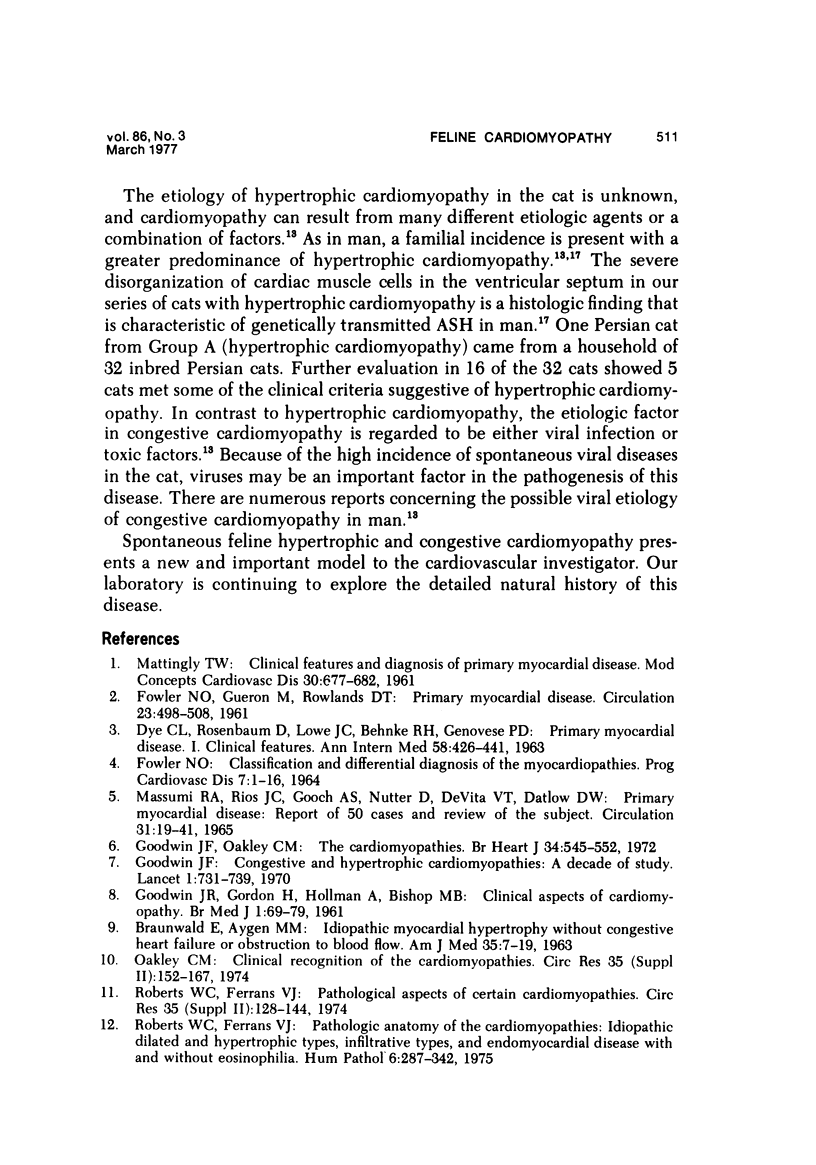

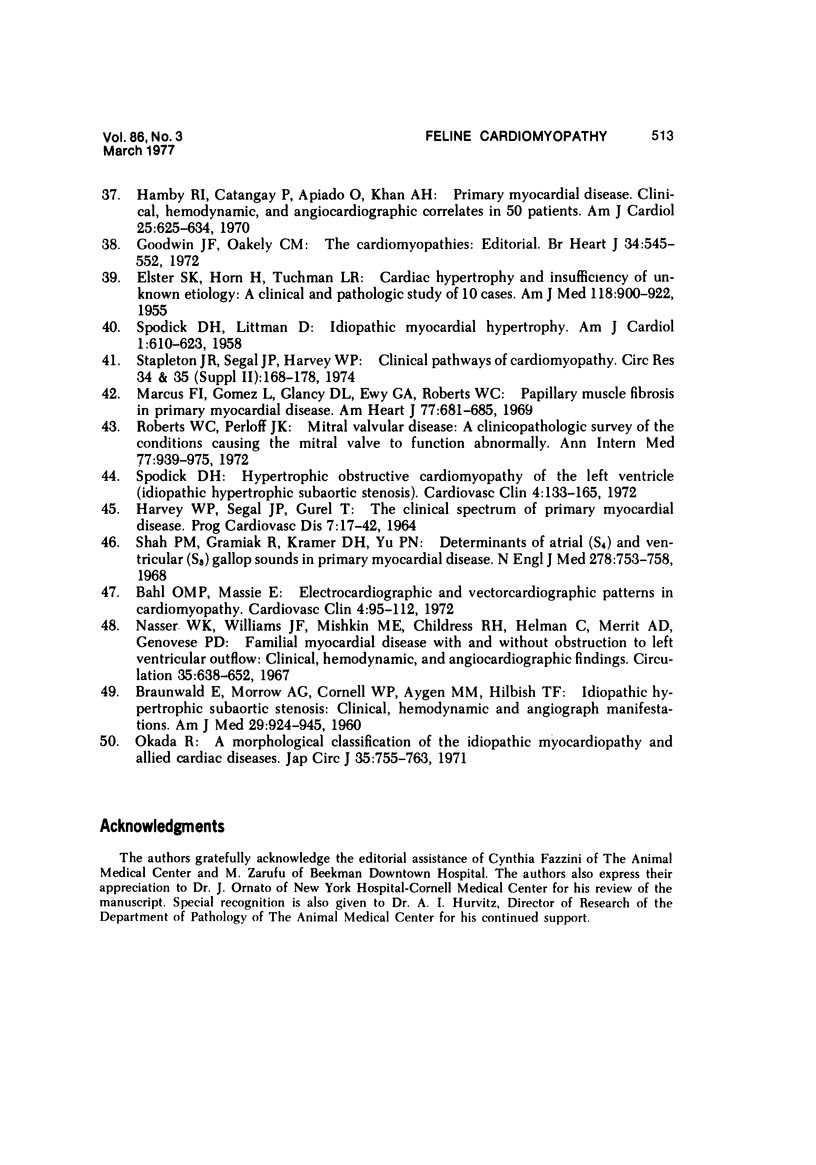
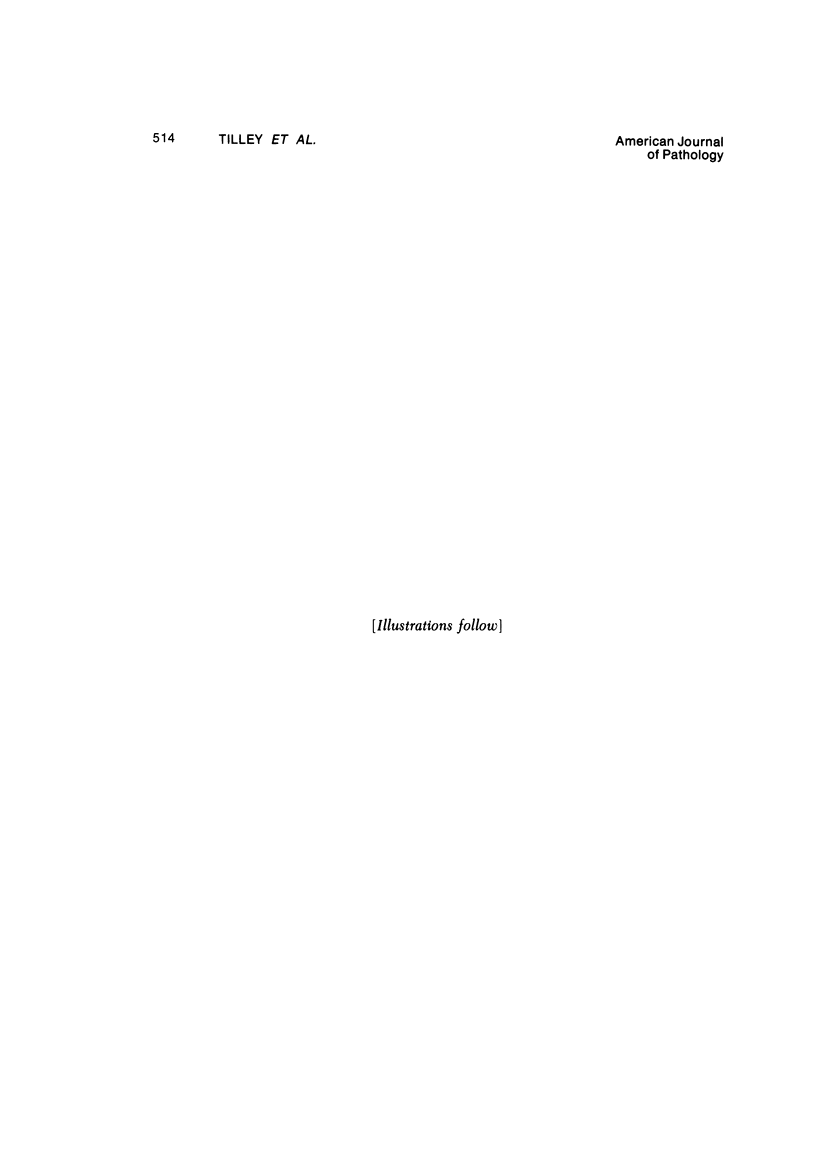
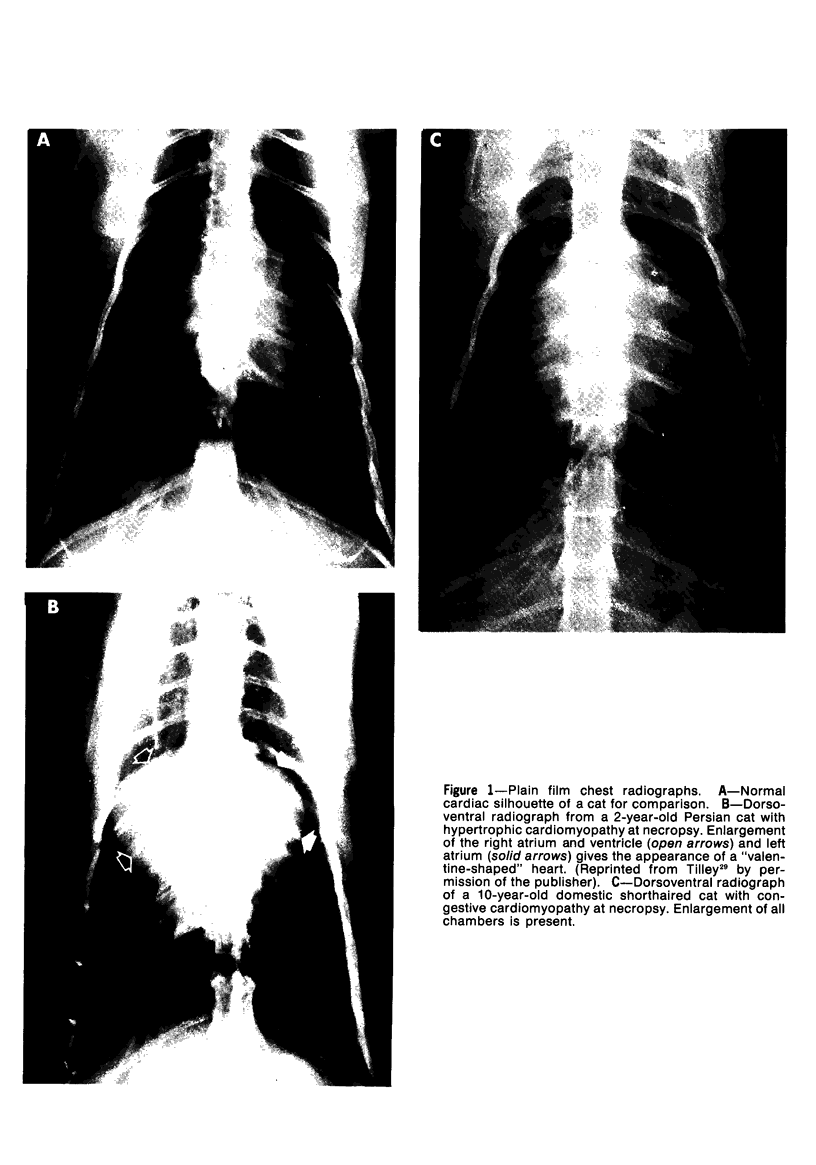
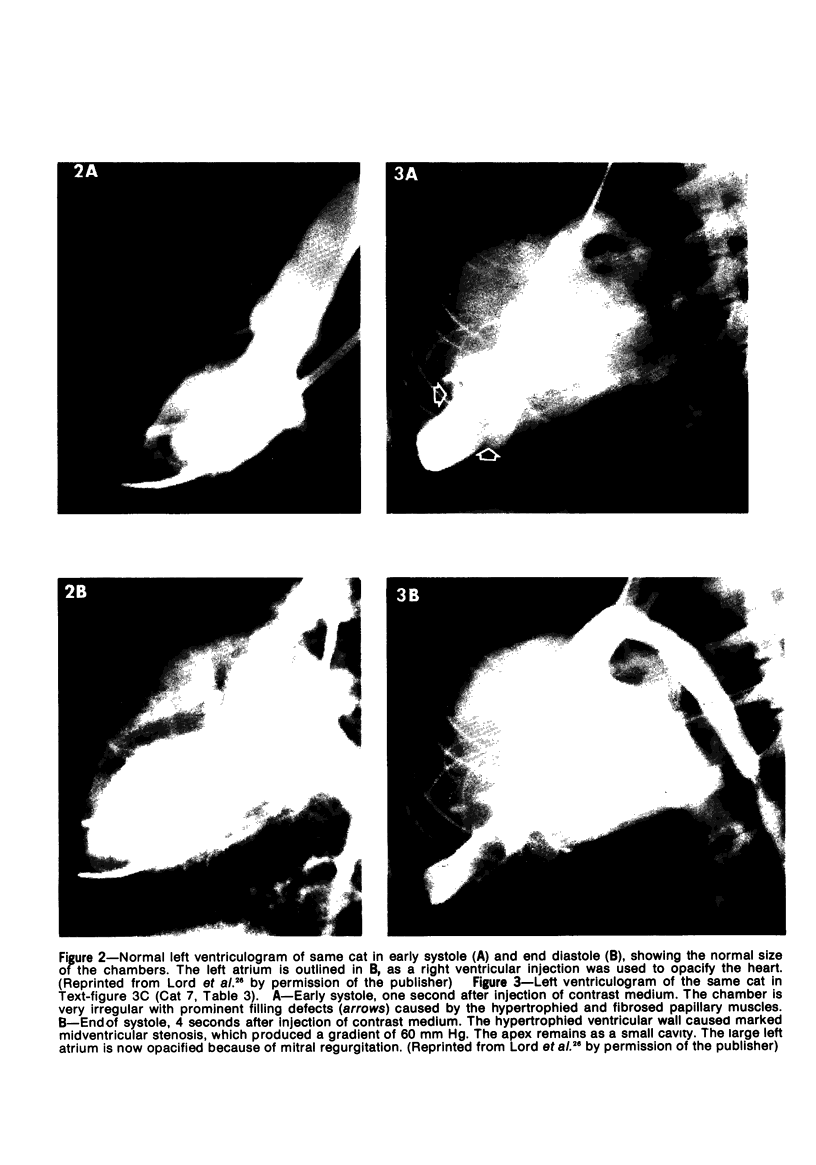
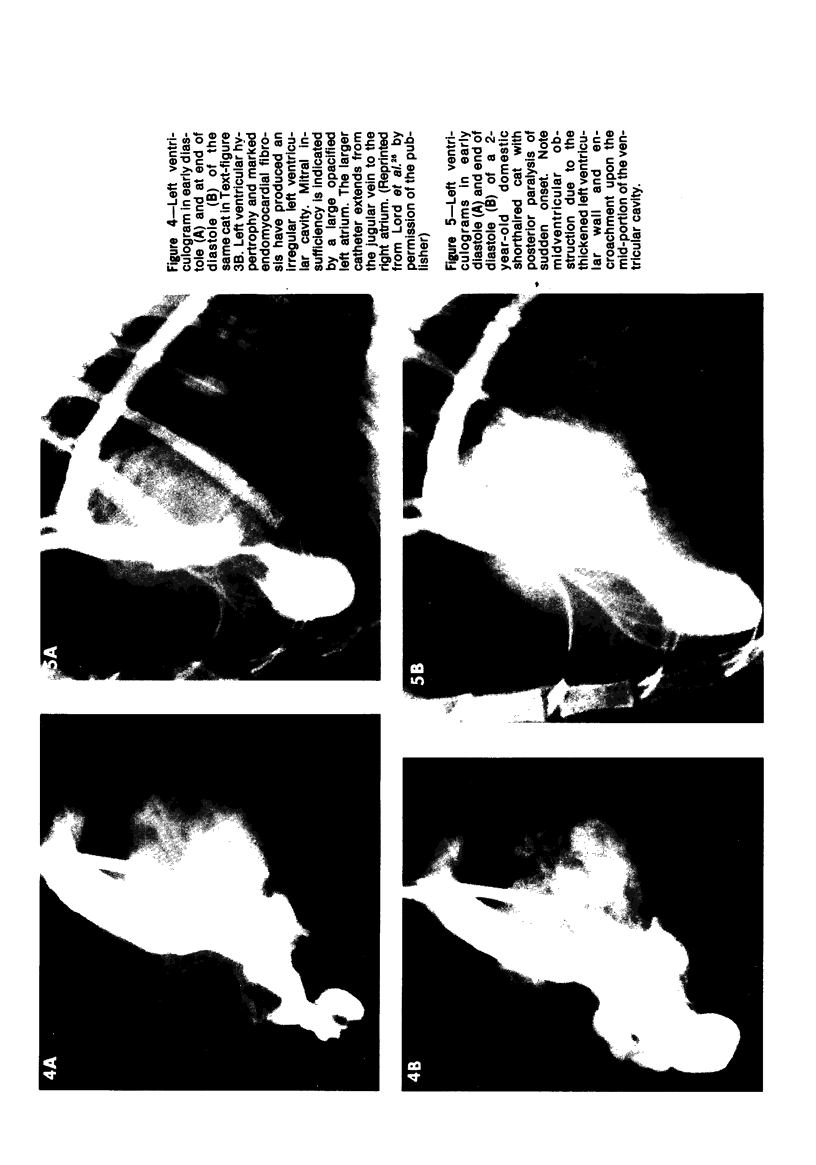
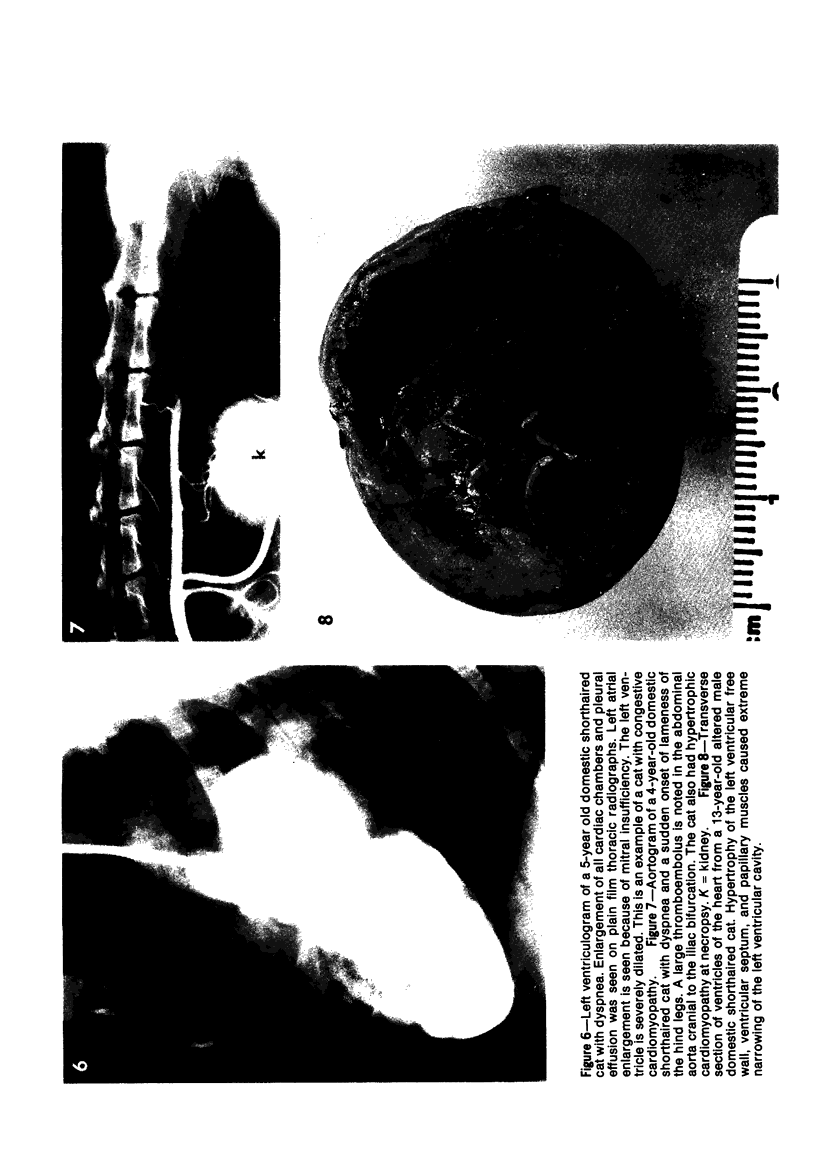
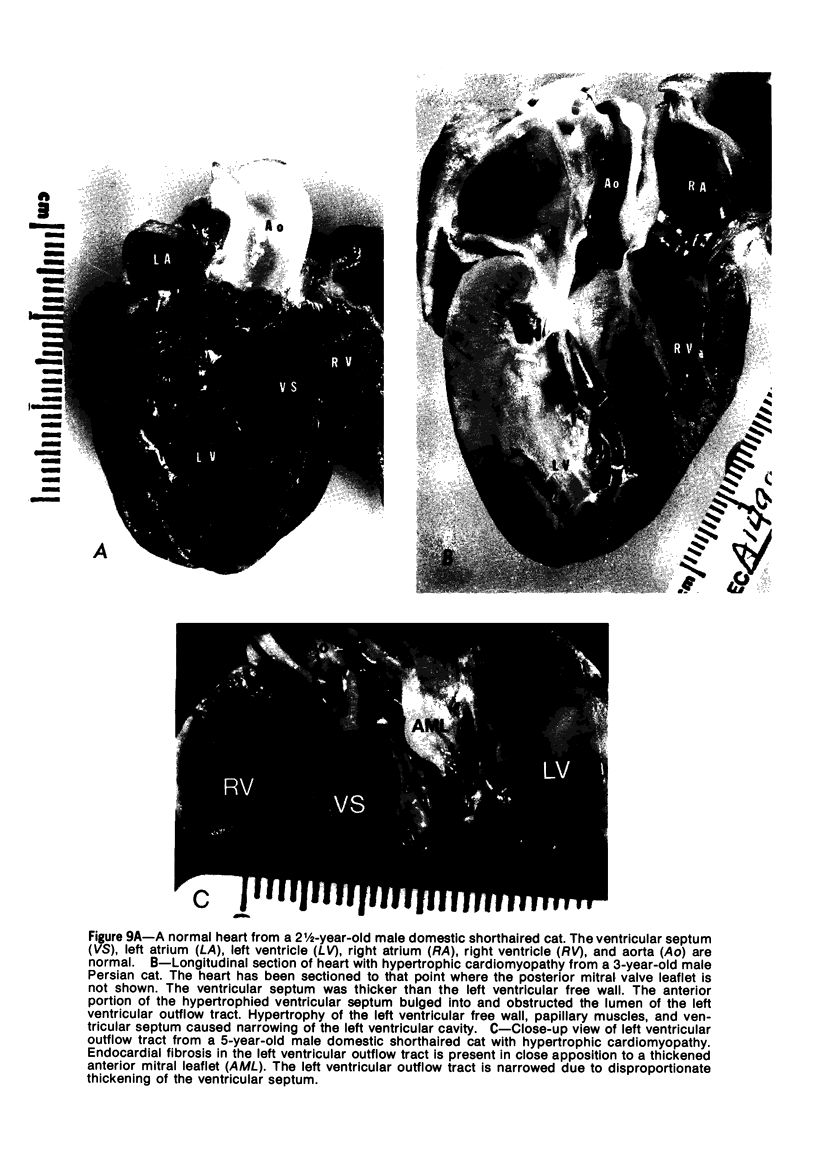
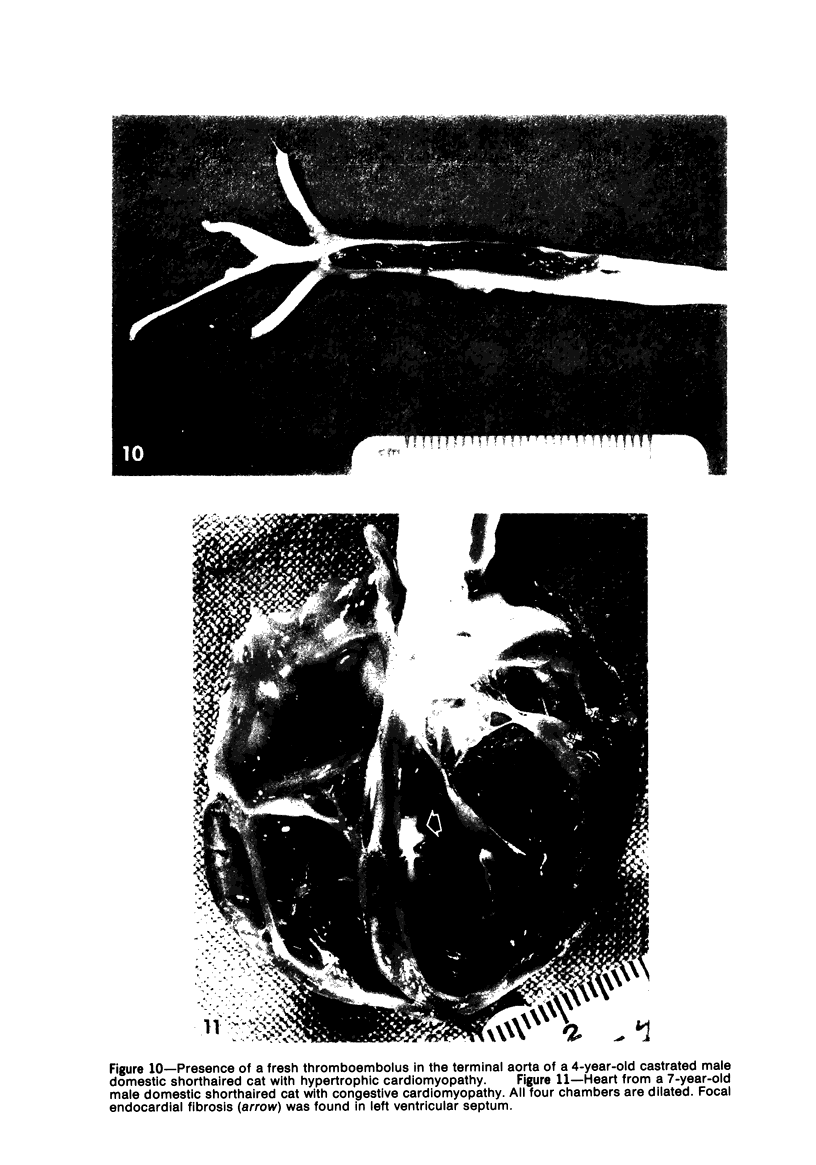
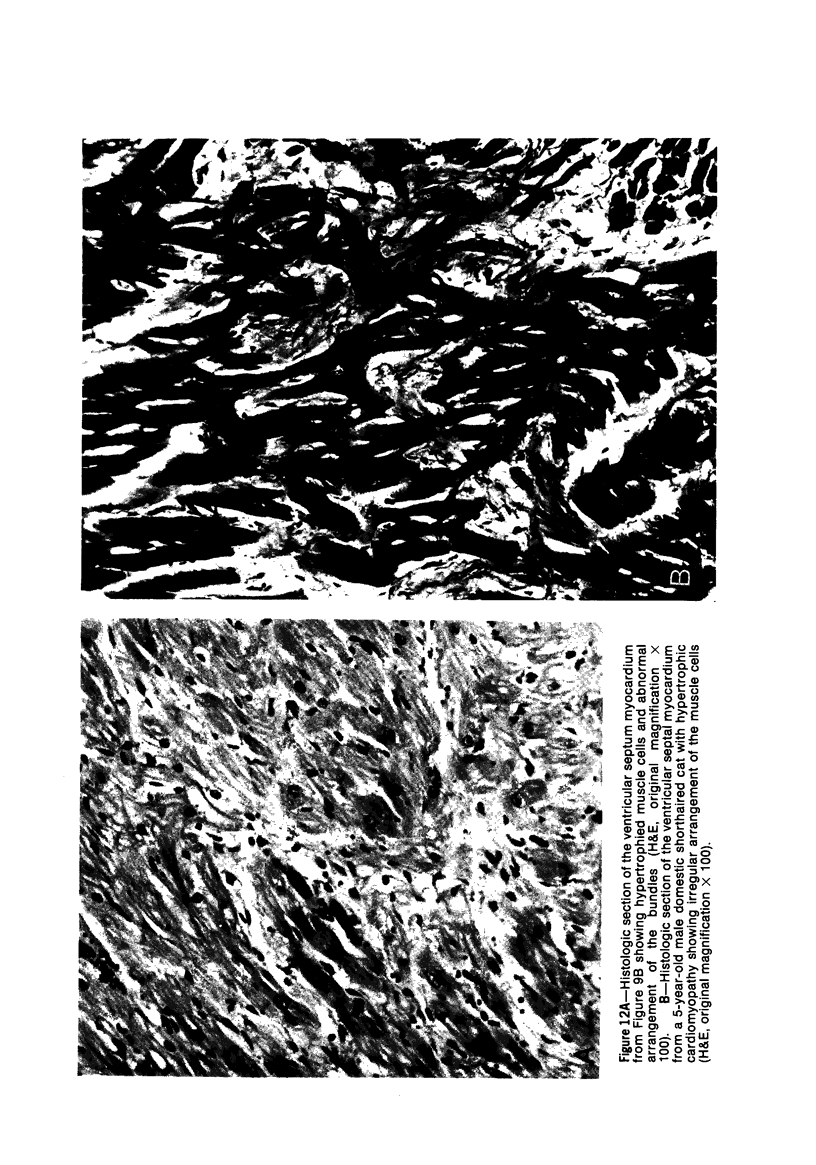
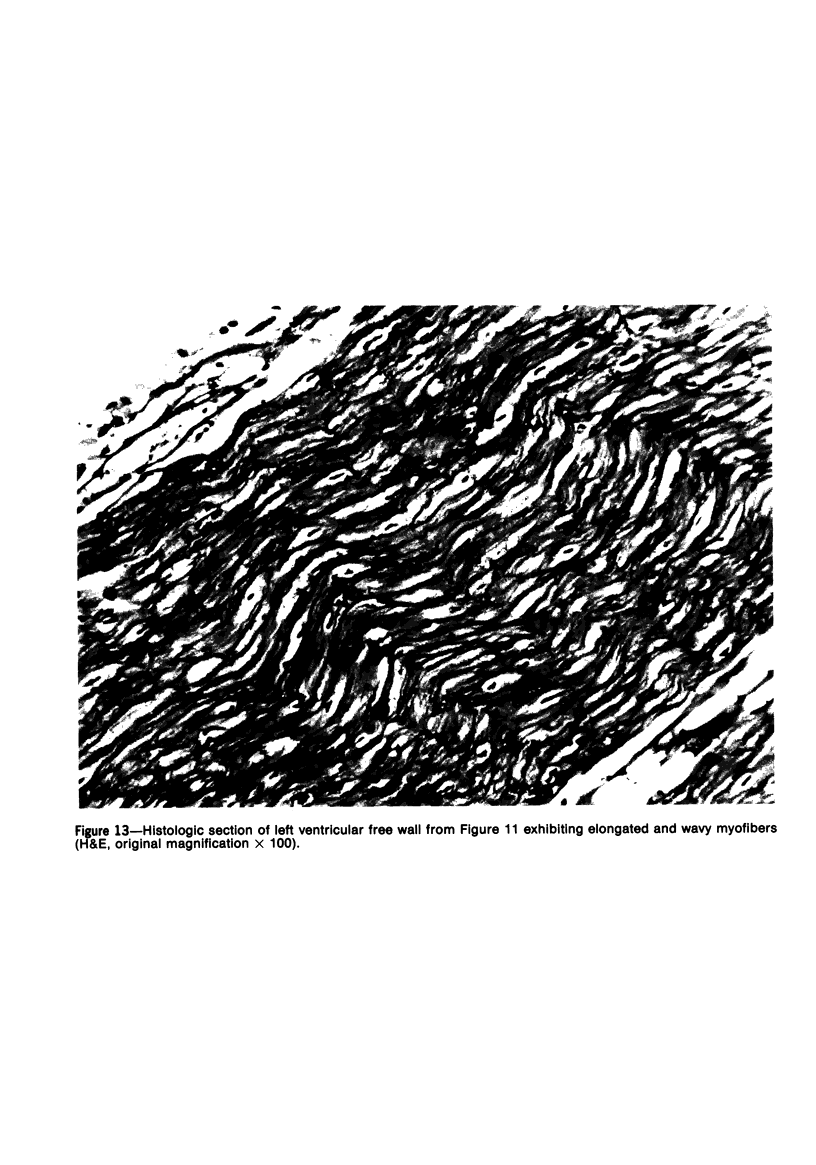
Images in this article
Selected References
These references are in PubMed. This may not be the complete list of references from this article.
- Asymmetric septal hypertrophy. Ann Intern Med. 1974 Nov;81(5):650–680. doi: 10.7326/0003-4819-81-5-650. [DOI] [PubMed] [Google Scholar]
- BLOCK J., BOELES J. T. The electrocardiogram of the normal cat. Acta Physiol Pharmacol Neerl. 1957;6:95–102. [PubMed] [Google Scholar]
- BRAUNWALD E., AYGEN M. M. IDIOPATHIC MYOCARDIAL HYPERTROPHY WITHOUT CONGESTIVE HEART FAILURE OR OBSTRUCTION TO BLOOD FLOW. CLINICAL, HEMODYNAMIC AND ANGIOCARDIOGRAPHIC STUDIES IN FOURTEEN PATIENTS. Am J Med. 1963 Jul;35:7–19. doi: 10.1016/0002-9343(63)90159-1. [DOI] [PubMed] [Google Scholar]
- BRAUNWALD E., LAMBREW C. T., ROCKOFF S. D., ROSS J., Jr, MORROW A. G. IDIOPATHIC HYPERTROPHIC SUBAORTIC STENOSIS. I. A DESCRIPTION OF THE DISEASE BASED UPON AN ANALYSIS OF 64 PATIENTS. Circulation. 1964 Nov;30:SUPPL 4–119. doi: 10.1161/01.cir.29.5s4.iv-3. [DOI] [PubMed] [Google Scholar]
- Bahl O. P., Massie E. Electrocardiographic and vectorcardiographic patterns in cardiomyopathy. Cardiovasc Clin. 1972;4(1):95–112. [PubMed] [Google Scholar]
- Buchanan J. W., Baker G. J., Hill J. D. Aortic embolism in cats: prevalence, surgical treatment and electrocardiography. Vet Rec. 1966 Oct 29;79(18):496–505. doi: 10.1136/vr.79.18.496. [DOI] [PubMed] [Google Scholar]
- COHEN J., EFFAT H., GOODWIN J. F., OAKLEY C. M., STEINER R. E. HYPERTROPHIC OBSTRUCTIVE CARDIOMYOPATHY. Br Heart J. 1964 Jan;26:16–32. doi: 10.1136/hrt.26.1.16. [DOI] [PMC free article] [PubMed] [Google Scholar]
- ELSTER S. K., HORN H., TUCHMAN L. R. Cardiac hypertrophy and insufficiency of unknown etiology; a clinical and pathologic study of ten cases. Am J Med. 1955 Jun;18(6):900–922. doi: 10.1016/0002-9343(55)90172-8. [DOI] [PubMed] [Google Scholar]
- FOWLER N. O. CLASSIFICATION AND DIFFERENTIAL DIAGNOSIS OF THE MYOCARDIOPATHIES. Prog Cardiovasc Dis. 1964 Jul;7:1–16. doi: 10.1016/s0033-0620(64)80027-x. [DOI] [PubMed] [Google Scholar]
- FOWLER N. O., GUERON M., ROWLANDS D. T., Jr Primary myocardial disease. Circulation. 1961 Apr;23:498–508. doi: 10.1161/01.cir.23.4.498. [DOI] [PubMed] [Google Scholar]
- Fowler N. O. Diagnosis of the myocardial diseases. Cardiovasc Clin. 1972;4(1):77–94. [PubMed] [Google Scholar]
- Freak M. J. Symposium on thrombosis. I. Arterial thrombosis (embolism) in the cat. J Small Anim Pract. 1966 Nov;7(11):711–717. doi: 10.1111/j.1748-5827.1966.tb04397.x. [DOI] [PubMed] [Google Scholar]
- GOODWIN J. F., GORDON H., HOLLMAN A., BISHOP M. B. Clinical aspects of cardiomyopathy. Br Med J. 1961 Jan 14;1(5219):69–79. doi: 10.1136/bmj.1.5219.69. [DOI] [PMC free article] [PubMed] [Google Scholar]
- Goodwin J. F. Congestive and hypertrophic cardiomyopathies. A decade of study. Lancet. 1970 Apr 11;1(7650):732–739. [PubMed] [Google Scholar]
- Goodwin J. F., Oakley C. M. The cardiomyopathies. Br Heart J. 1972 Jun;34(6):545–552. doi: 10.1136/hrt.34.6.545. [DOI] [PMC free article] [PubMed] [Google Scholar]
- Goodwin J. F., Oakley C. M. The cardiomyopathies. Br Heart J. 1972 Jun;34(6):545–552. doi: 10.1136/hrt.34.6.545. [DOI] [PMC free article] [PubMed] [Google Scholar]
- HAMLIN R. L., SMETZER D. L., SMITH C. R. RADIOGRAPHIC ANATOMY OF THE NORMAL CAT HEART. J Am Vet Med Assoc. 1963 Nov 1;143:957–961. [PubMed] [Google Scholar]
- HAMLIN R. L., SMETZER D. L., SMITH C. R. The electrocardiogram, phonocardiogram, and derived ventricular activation process of domestic cats. Am J Vet Res. 1963 Jul;24:792–802. [PubMed] [Google Scholar]
- HARVEY W. P., SEGAL J. P., GUREL T. THE CLINICAL SPECTRUM OF PRIMARY MYOCARDIAL DISEASE. Prog Cardiovasc Dis. 1964 Jul;7:17–42. doi: 10.1016/s0033-0620(64)80028-1. [DOI] [PubMed] [Google Scholar]
- Hamby R. I., Catangay P., Apiado O., Khan A. H. Primary myocardial disease. Clinical, hemodynamic and angiocardiographic correlates in fifty patients. Am J Cardiol. 1970 Jun;25(6):625–634. doi: 10.1016/0002-9149(70)90610-7. [DOI] [PubMed] [Google Scholar]
- Liu S. K. Acquired cardiac lesions leading to congestive heart failure in the cat. Am J Vet Res. 1970 Nov;31(11):2071–2088. [PubMed] [Google Scholar]
- Liu S. K., Tashjian R. J., Patnaik A. K. Congestive heart failure in the cat. J Am Vet Med Assoc. 1970 May 1;156(9):1319–1330. [PubMed] [Google Scholar]
- Lord P. F., Wood A., Tilley L. P., Liu S. K. Radiographic and hemodynamic evaluation of cardiomyopathy and thromboembolism in the cat. J Am Vet Med Assoc. 1974 Jan 15;164(2):154–165. [PubMed] [Google Scholar]
- MASSUMI R. A., RIOS J. C., GOOCH A. S., NUTTER D., DEVITA V. T., DATLOW D. W. PRIMARY MYOCARDIAL DISEASE: REPORT OF FIFTY CASES AND REVIEW OF THE SUBJECT. Circulation. 1965 Jan;31:19–41. doi: 10.1161/01.cir.31.1.19. [DOI] [PubMed] [Google Scholar]
- MATTINGLY T. W. Clinical features and diagnosis of primary myocardial disease. II. Mod Concepts Cardiovasc Dis. 1961 Aug;30:677–contd. [PubMed] [Google Scholar]
- Marcus F. I., Gomez L., Glancy D. L., Ewy G. A., Roberts W. C. Papillary muscle fibrosis in primary myocardial disease. Am Heart J. 1969 May;77(5):681–685. doi: 10.1016/0002-8703(69)90555-9. [DOI] [PubMed] [Google Scholar]
- Nasser W. K., Williams J. F., Mishkin M. E., Childress R. H., Helmen C., Merritt A. D., Genovese P. D. Familial myocardial disease with and without obstruction to left ventricular outflow. Clinical, hemodynamic, and angiographic findings. Circulation. 1967 Apr;35(4):638–652. doi: 10.1161/01.cir.35.4.638. [DOI] [PubMed] [Google Scholar]
- Oakley C. M. Clinical recognition of the cardiomyopathies. Circ Res. 1974 Aug;35(2):suppl II–II:167. [PubMed] [Google Scholar]
- Okada R. A morphological classification of the idiopathic myocardiopathy and allied cardiac diseases. Jpn Circ J. 1971 Jul;35(7):755–763. doi: 10.1253/jcj.35.755. [DOI] [PubMed] [Google Scholar]
- Roberts W. C., Ferrans V. J. Pathologic anatomy of the cardiomyopathies. Idiopathic dilated and hypertrophic types, infiltrative types, and endomyocardial disease with and without eosinophilia. Hum Pathol. 1975 May;6(3):287–342. [PubMed] [Google Scholar]
- Roberts W. C., Ferrans V. J. Pathological aspects of certain cardiomyopathies. Circ Res. 1974 Aug;35(2):suppl II–II:144. [PubMed] [Google Scholar]
- Roberts W. C., Perloff J. K. Mitral valvular disease. A clinicopathologic survey of the conditions causing the mitral valve to function abnormally. Ann Intern Med. 1972 Dec;77(6):939–975. doi: 10.7326/0003-4819-77-6-939. [DOI] [PubMed] [Google Scholar]
- Rogers W. A., Bishop S. P. Electrocardiographic parameters of the normal domestic cat: a comparison of standard limb leads and an orthogonal system. J Electrocardiol. 1971;4(4):315–321. doi: 10.1016/s0022-0736(71)80016-x. [DOI] [PubMed] [Google Scholar]
- SPODICK D. H., LITTMANN D. Idiopathic myocardial hypertrophy. Am J Cardiol. 1958 May;1(5):610–623. doi: 10.1016/0002-9149(58)90145-0. [DOI] [PubMed] [Google Scholar]
- Shah P. M., Gramiak R., Kramer D. H., Yu P. N. Determinants of atrial (S4) and ventricular (S3) gallop sounds in primary myocardial disease. N Engl J Med. 1968 Apr 4;278(14):753–758. doi: 10.1056/NEJM196804042781402. [DOI] [PubMed] [Google Scholar]
- Spodick D. H. Hypertrophic obstructive cardiomyopathy of the left ventricle (idiopathic hypertrophic subaortic stenosis). Cardiovasc Clin. 1972;4(1):133–165. [PubMed] [Google Scholar]
- TEARE D. Asymmetrical hypertrophy of the heart in young adults. Br Heart J. 1958 Jan;20(1):1–8. doi: 10.1136/hrt.20.1.1. [DOI] [PMC free article] [PubMed] [Google Scholar]
- Tilley L. P. Cardiomyopathy and thromboembolism in the cat. Vet Med Small Anim Clin. 1975 Mar;70(3):313–316. [PubMed] [Google Scholar]



